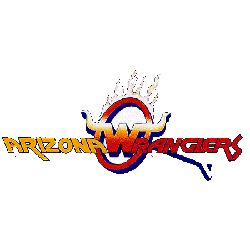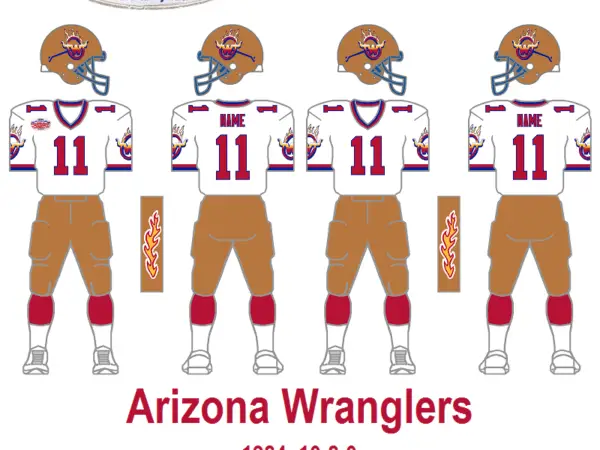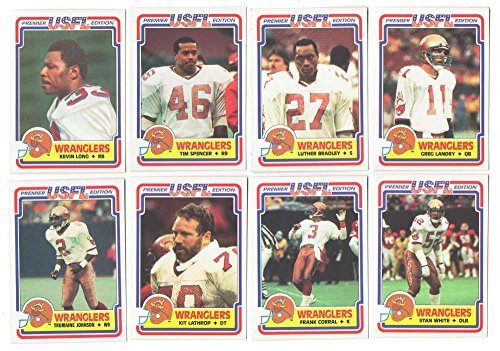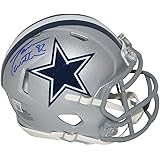
Established
1983
City
Tempe – Oklahoma City – Tempe
League History
1983 – 1986 / United States Football League
Team History
1985 / Arizona Outlaws
1983 – 1984 / Arizona Wranglers
1984 / Oklahoma Outlaws
Nickname
Wranglers – The Arizona Wranglers are one of the most iconic teams in USFL history, and their nickname is steeped in a rich history. “Wrangler” was chosen to honor the state’s cowboy heritage and its ties to professional football.
In 1982, when the team began playing in Tempe Stadium, they were known simply as "the Arizona Football Team." But that all changed on August 8th when owner Jim Joseph announced that he had selected "Wranglers" for their official moniker. He chose this name because it symbolized strength and determination - two traits that he felt would be essential for success on the field.
The logo was designed by local artist David Johnson who wanted to capture some of those same qualities with his design, so he used an image of a bucking bronco with a lasso flying behind him against a desert backdrop – perfectly representing not only Arizona's western spirit but also its fiercely competitive nature! The colors red & white were chosen because they represented courage & power, respectively (as well as traditional American football colors).
This combination proved popular among fans across America, and soon enough, “Arizona Wranglers” became synonymous with excellence throughout professional sports circles! So if you're ever wondering why this team has such an excellent nickname – now you know: It pays homage to our state's proud past & bright future while also embodying everything we love about American Football!
Original USFL Team
Yes
Final USFL Team
No
Team’s Final Outlook
A deal was made in which Tatham acquired the Wranglers’ assets. Since Tatham acquired all the Wranglers’ player contracts, the deal was widely reported as a merger. Tatham relocated the Outlaws to Arizona for the 1985 season, merging the rosters into the Arizona Outlaws.
Championship
USFL Championship 0
Stadium
1983 – 1985 / Sun Devil Stadium
*Oklahoma*
1984 / Skelly Stadium
Owner
1984 – 1986 / William R. Tatham Sr., William R. Tatham Jr.
1984 / Dr. Ted Diethrich
1983 / Jim Joseph
Coaches
1985 / Frank Kush (8 wins – 10 losses)
1984 / Woody Widenhofer (6 wins – 12 losses)
1984 / George Allen (12 wins – 9 losses)
1983 / Doug Shivley (4 wins – 14 losses)
- 1982
- 1984
- 1985
-
Wranglers Team Formation
The team that would eventually become the Arizona Wranglers was originally supposed to be the USFL’s Los Angeles franchise. The team’s planned original owner, Alex Spanos, pulled out of his USFL commitment and instead bought a minority stake in the NFL’s San Diego Chargers. The owners of the Oakland Invaders, Bay Area real estate executives Jim Joseph and Tad Taube, ... -
Merge with the Chicago Blitz
Joseph lost millions of dollars in the 1983 season. Like most of the other owners, he’d bought into the league knowing to expect years of losses. However, he was disappointed in the team’s attendance and unwilling to stick it out in Arizona. In a stroke of luck for Joseph, Chicago Blitz owner Dr. Ted Diethrich (a Phoenix resident and founder ... -
Joining with Oklahoma Outlaws
Despite making it to the Championship game, Diethrich was bleeding in red ink. He expected his all-star team’s attendance to be much greater than the 25,776 fans per game the no-name Wranglers averaged in 1983. However, as had been the case a year earlier, Phoenix-area fans viewed the Wranglers mostly with indifference. Despite fielding a winning team, the Wranglers’ 1984 ...
To qualify as the greatest player for this team, the player must have played one season for this team. If not, we will remove the player.
* verifies that player has played for this team as an added player by a fan.
History of the Wranglers
The Arizona Wranglers were a professional football team that played in the United States Football League (USFL) from 1983 to 1985. Founded by real estate developer and former NFL player Jerry Argovitz, the team was based out of Phoenix, Arizona, and played its home games at Sun Devil Stadium on the campus of Arizona State University. The Wranglers were one of twelve teams that made up the USFL during its three-year existence and quickly became one of the league’s most successful franchises.
In their first season under head coach Jim Hanifan, the Wranglers finished with an 11–7 record, earning them second place in their division behind only Steve Young’s Los Angeles Express. Led by veteran quarterback Doug Williams who threw for 3,094 yards with 17 touchdowns, and running back Gary Anderson, who rushed for 1,104 yards with 13 touchdowns, they advanced to playoffs. Still, they lost in the semi-finals against eventual champion Michigan Panthers 16–3. In 1984 they improved even further, finishing 12–6 while making it all way to the championship game, where they narrowly lost 23–3 against Philadelphia Stars led by future Hall-of-Famer Reggie White despite having a home-field advantage due to bad weather conditions at Sun Devil Stadium caused delay kickoff time until midnight local time resulting low turnout crowd less than 10 thousand people instead expected sellout capacity over 60 thousand seat stadium could hold.
The following year saw a decline performance-wise, ending 8--10, but still managed to make playoffs once again, losing the quarter-final round 26--24 Oakland Invaders after controversial call officials disallowed what would have been a winning touchdown late fourth quarter when the clock ran out before the snap ball took place thus denying them chance reach third consecutive title game appearance. Despite not winning the championship during the short tenure of franchise history, Arizona Wrangler's legacy remains strong among fans, both old and new alike testament to success achieved within a relatively brief period of existence.
Sports Fan Products
Accomplishments
1984 / USFL Championship Game (vs Philadelphia Stars 3 – 23)
1984 / Conference Champions (vs Los Angeles Express 35 – 23)
1984 / Division Champions (vs Houston Gamblers 17 – 16)
Averaged 25,776 in 1983 and 25,568 in 1984 (70,491 seat stadium)
*Blue is this team’s history





























